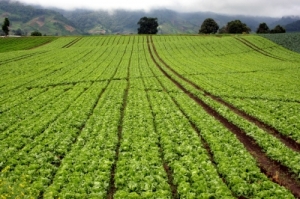 Between 1980 and 2000 over half of new agricultural land in the tropics was created through cutting down intact forest. Land clearing for crop production is a major issue for the maintenance of biodiversity and environmental stability but growing human demand for food is only one of several pressures on land, a resource that is rapidly shrinking.
Between 1980 and 2000 over half of new agricultural land in the tropics was created through cutting down intact forest. Land clearing for crop production is a major issue for the maintenance of biodiversity and environmental stability but growing human demand for food is only one of several pressures on land, a resource that is rapidly shrinking.
Recently we at Agriculture for Impact came across a paper investigating global land scarcity, a topic much discussed in One Billion Hungry and on this blog. Published in 2011, the paper by Dr Lambin of Stanford University and Dr Meyfroidt of the University of Louvain, entitled Global land use change, economic globalization and the looming land scarcity, documents the processes that are driving global land use change and estimates when we might run out of land.
Of the total ice free land on the planet (13,300 million hectares), around 4,000Mha is suitable for rain-fed agriculture. The amount of land that is currently uncultivated, that isn’t forested, protected or populated by more than 25 people per km2 is estimated at 445Mha and occurs mainly in the cerrados and grasslands of Latin America and the savannahs of Africa, which are important in themselves for biodiversity conservation and livestock grazing. The paper’s authors calculate low and high estimates of the amount of land needed to supply demand for different competing land uses:
Cropland for human food – an additional 2.7-4.9Mha each year depending on food waste, diets and efficiency.
Biofuels – 1.5-3.9Mha per year based on current biofuel mandates
Pasture – 0-5Mha per year based on the projected intensification of livestock systems
Urbanisation – 1.6-3.3Mha per year
Industrial forestry – 1.9-3.6Mha per year
Protected areas – 0.9-2.7Mha per year
Land degradation – 1-2.9Mha of land will be lost each year
Added together and balanced against current available land, and assuming that some deforestation will occur, means that current land reserves will run out by the late 2020s at the earliest and 2050 at the latest, and this is excluding the impacts of climate change.
The authors point to different solutions for managing this critical resource, land use zoning and agricultural intensification, but argue that while land use policy is implemented at a national scale, the pressure and demand for land for agriculture and other uses is a result of economic globalisation or the increasing interconnectedness of the world and separation between sites of production and consumption. For example, between 1961 and 2001 cross border trade in food commodities increased more than fivefold. In particular they point to four processes through which national land use is dictated at the global level:
- Displacement or leakage, whereby land use activities are changed in one place only to occur or migrate to another e.g. protecting a forest in one country may cause an increase in the amount of wood imported and cause deforestation in another country. Greater global trade can facilitate the redistribution of environmental impacts of land use change. An example of this is the set aside land policies in developed countries that between 1990 and 2004 caused these same countries to increase cereal imports per capita by 42.2% compared with an average 3.5% increase in imports for countries without these policies.
- Rebound or take-back effect, whereby an increase in efficiency brought about by the development and adoption of a new technology or practice can drive an increase in production through greater economic benefits. Although the amount of land needed to produce current levels of food would have been two to three times higher without yield increases, there is little evidence of a trend towards increasing yields resulting in reduced cropland.
- Cascade effects, whereby a series of events leads to land use change e.g. indirectly. For example, if land planted to a food crop is converted to biofuel production, the price of the food crop may go up, stimulating the production of that crop, and conversion of land, elsewhere. This is partly why first generation biofuels may have limited impact in reducing greenhouse gas emissions. One model estimates that to expand the area under biofuels to meet demand between 2000 and 2030, an additional 24Mha of forest need to be converted.
- Remittance effects, whereby as people migrate out of rural areas to towns and cities, they send money back to their rural families. This can have several hypothetical impacts: it could increase rural household income, reducing reliance on agriculture and relieving pressure on the land or it could fund agricultural intensification or extensification, depending on the context. There is little evidence regarding the effect of remittances on land use but in El Salvador, one study found those households receiving remittances cleared less forest than those households that did not receive them.
These four effects mean that national policies must consider the global impacts of land use policies. Global markets may respond to land scarcity by motivating more efficient land use e.g. second generation biofuels, high yielding crops, lower meat consumption and production, synthetic food etc. As the paper concludes global land use is an area that still needs much research but, since demand is certainly going to grow, we must shift to commodities that save land and that can be produced using sustainable land practices, and this shift needs to be facilitated with some urgency.









Leave a comment